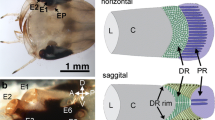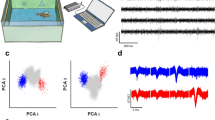Summary
The behavior of the marine mollusc Aplysia was examined under different experimental conditions designed to determine the food searching strategy of the animals. In a small, open field tank with still water, the animals took an average of 42 min to find a piece of seaweed, even though the stimulus was never located more than 30 cm away from the animal. Observations of the animals indicated that their search was not directed, without a clear tendency towards the food, and during the course of a search, they often crawled through most of the area of the tank. The search time, the distance travelled, and the strategy of the search of the animals was similar for different types of seaweed. If animals were aroused into activity by the presence of seaweed extract, the time for them to contact a piece of odorless glass fiber paper in the open field was not significantly different than that for a piece of seaweed. The probability at which the animals contacted the seaweed, as a function of the distance travelled, resembled the detection probability determined according to a theory of random search. We thus propose that the aroused animals move in a random pattern until they are very close to the food. This strategy can be advantageous in still water since chemicals do not provide distinct gradients that can serve as cues for chemotactic orientation from distances greater than a few centimeters from the source.
In a Y-maze in still water, Aplysia did not perform above chance in selecting the arm that contained the seaweed. In streaming water, the animals entered the arm that contained seaweed significantly above chance only if a large piece of seaweed was used, so as to provide a very strong stimulus. Similarly, presentation of a high concentration of glutamate or a high concentration of seaweed extract to one side of the animal could evoke turning towards the stimulus. In the Y-maze, animals that repeatedly entered and exited both arms before making a choice, performed better than those that went directly into one arm.
We conclude that chemical food stimuli can evoke directed orientation only when the animal is very close to the stimulus (within a few centimeters, at most). For Aplysia, the role of distant chemical stimuli may not be to guide their orientation, but rather to evoke the food-induced arousal state. In this behavioral state, several behaviors, such as locomotion are altered, and these changes may provide the basis for locating food from a distance.
Similar content being viewed by others

Abbreviations
- SWE :
-
seaweed extract
References
Atema J (1985) Chemoreception in the sea: adaptation of chemoreceptors and behaviour to aquatic stimulus conditions. Soc Exp Biol Symp 39:387–423
Atema J (1988) Distribution of chemical stimuli. In: Atema J, Fay RR, Popper AN, Tavolga WN (eds) Sensory biology of aquatic animals. Springer, New York Berlin Heidelberg, pp 29–56
Audesirk TE (1975) Chemoreception in Aplysia californica. I. Behavioral localization of distance chemoreceptors used in food-finding. Behav Biol 15:45–55
Bell WJ, Tobin TR (1982) Chemo-orientation. Biol Rev 57:219–260
Bossert WH, Wilson EO (1963) The analysis of olfactory communication among animals. J Theoret Biol 5:443–469
Bousfield JD (1978) Rheotaxis and Chemoreception in the fresh-water snail Biomphalaria glabrata (Say): estimation of the molecular weights of active factors. Biol Bull 154:361–373
Bovbjerg RV (1968) Responses to food in lymnaeid snails. Physiol Zool 41(4): 414–423
Cardé RT (1984) Chemo-orientation in flying insects. In: Bell WJ, Cardé RT (eds) Chemical ecology of insects. Sinauer, Sunderland, pp 111–124
Carefoot TH (1987) Aplysia: its biology and ecology. Oceanogr Mar Biol Annu Rev 25:167–284
Chelazzi G (1990) Eco-ethological aspects of homing behaviour in molluscs. Ethol Ecol Evol 2:11–26
Copeland M (1918) The olfactory reactions and organs of the marine snails Alectrion obsoleta (Say) and Busycon canaliculatum (Linn.). J Exp Zool 25:177–227
Croll RP (1983) Gastropod chemoreception. Biol Rev 58:293–319
Elkinton JS, Cardé RT (1984) Odor dispersion. In: Bell WJ, Cardé RT (eds) Chemical ecology of insects. Sinauer, Sunderland, pp 73–91
Field LH, Macmillan DL (1973) An electrophysiological and behavioural study of sensory responses in Tritonia (Gastropoda, Nudibranchia). Mar Behav Physiol 2:171–185
Fraenkel GS, Gunn DL (1961) The orientation of animals — kineses, taxes and compass reactions (2nd ed). Dover Publ, New York
Frings H, Frings C (1965) Chemosensory bases of food-finding and feeding in Aplysia juliana (Mollusca, Opisthobranchia). Biol Bull 128:211–217
Jahan-Parwar B (1972) Behavioral and electrophysiological studies on chemoreception in Aplysia. Am Zool 12:529–537
Jahan-Parwar B (1975) Chemoreception in gastropods. In: Denton DA, Coghlan JP (eds) Olfaction and taste, vol. V. Academic Press, New York, pp 133–140
Kaissling K-E (1987) R.H. Wright lectures on insect olfaction. Simon Fraser University, Burnaby, B.C.
Kennedy JS, Ludlow AR, Sanders CJ (1980) Guidance system used in moth sex attraction. Nature 288:475–477
Kleerekoper H (1969) Olfaction in fishes. Indiana University Press, Bloomington
Kohn AJ (1961) Chemoreception in gastropod molluscs. Am Zool 1:291–308
Kupfermann I (1974) Feeding behavior in Aplysia: a simple system for the study of motivation. Behav Biol 10:1–26
Kupfermann I, Rosen S, Teyke T, Cropper EC, Miller M, Villim F, Weiss KR (1989) Neurobiology of behavioral states in Aplysia: Non-associative forms of plasticity of feeding responses. In: Elsner N, Singer W (eds) Dynamics and plasticity in neuronal systems. Thieme, Stuttgart New York, pp 47–59
Kupfermann I, Teyke T, Rosen SC, Weiss KR (1991) Studies of behavioral state in Aplysia. Biol Bull 180:262–268
Lederhendler II, Herriges K, Tobach E (1977) Taxis in Aplysia dactylomela (Rang, 1828) to water-borne stimuli from conspecifics. Anim Learn Behav 5(4): 355–358
Lee RM, Robbins MR, Palovcik R (1974) Pleurobranchaea behavior: food finding and other aspects of feeding. Behav Biol 12:297–315
Murliss J, Jones CD (1981) Fine-scale structure of odour plumes in relation to insect orientation to distant pheromone and other attractant sources. Physiol Entomol 6:71–86
Preston RJ, Lee RM (1973) Feeding behavior in Aplysia californica: role of chemical and tactile stimuli. J Comp Physiol Psychol 82:368–381
Stone LD (1975) Theory of optimal search. Academic Press, New York San Francisco London
Susswein AJ, Kupfermann I, Weiss KR (1976) The stimulus control of biting in Aplysia. J Comp Physiol 108:75–96
Susswein AJ, Cappell MS, Bennett MVL (1982) Distance chemoreception in Navanax inermis. Mar Behav Physiol 8:231–241
Teyke T, Weiss KR, Kupfermann I (1990a) An identified neuron (CPR) evokes neuronal responses reflecting food arousal in Aplysia. Science 247:85–87
Teyke T, Weiss KR, Kupfermann I (1990b) Appetitive feeding behavior in Aplysia: behavioral and neural analysis of directed head turning. J Neurosci 10:3922–3934
Townsend CR (1973) The food-finding orientation mechanism of Biomphalaria glabrata (Say). Anim Behav 21:544–548
Wolper C (1950) Das Osphradium der Paludina viviparia. Z Vergl Physiol 32:272–286
Author information
Authors and Affiliations
Rights and permissions
About this article
Cite this article
Teyke, T., Weiss, K.R. & Kupfermann, I. Orientation of Aplysia californien to distant food sources. J Comp Physiol A 170, 281–289 (1992). https://doi.org/10.1007/BF00191416
Accepted:
Issue Date:
DOI: https://doi.org/10.1007/BF00191416



